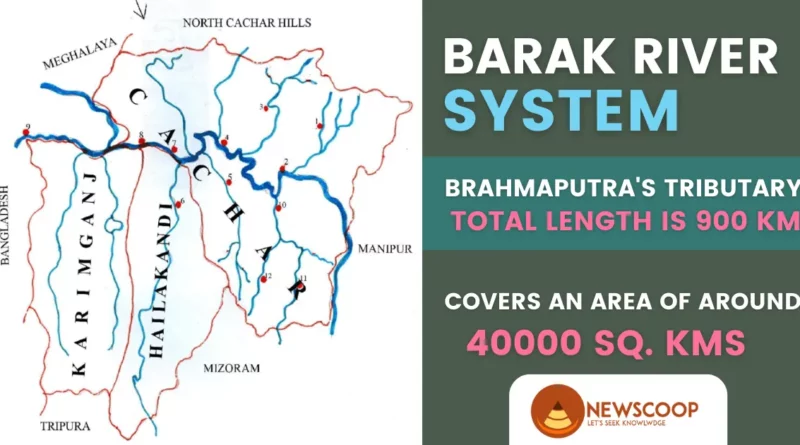Barak River
Barak River is a major river in the Northeastern region of India, which is situated in the states of Manipur, Mizoram, Assam, and Nagaland. It is a tributary of the Brahmaputra River and has a length of 900 kilometers. Further, the Barak River is an essential waterway that plays a crucial role in the lives of the people in the region. The river has a unique ecology and is home to various species of fish and other aquatic animals.
The Barak River originates in the Manipur Hills and flows through Mizoram and Assam before joining the Brahmaputra River in Bangladesh. The river is about 450 km long in Assam and is also known as the Surma River in Bangladesh. It is a major source of water for irrigation and fishing, and it also serves as a vital transportation route for goods and people.
In addition, the Barak River is fed by several tributaries, including the Jiri, Irang, Makru, and Tuivai Rivers. It has a total drainage area of around 40,000 square kilometers, and its water volume varies depending on the season. During the monsoon season, the river’s flow rate increases, and it can become dangerous for navigation.
| River | Barak River |
| Origin | Manipur hills |
| Area cover | 40,000 km sq. |
| Total Length | 900 km |
| Flows through | Manipur, Mizoram, Assam, and Nagaland |
| Dams | Khuga Dam Tipaimukh Dam Dolaithabi Barrage Katakhal Barrage |
| Major Tributaries | Jiri River Makru River Tuivai River Chiri River, etc. |
Barak River System
Here are some important facts about the Barak River in points:
- The Barak River is a major river in Northeast India that flows through the states of Manipur, Mizoram, and Assam before joining the Brahmaputra River in Bangladesh.
- It is formed by the confluence of two smaller rivers, the Barail and the Senai, in Manipur.
- The total length of the river is approximately 900 kilometers.
- The river has several tributaries, including those on the right and left banks, such as Jiri, Tuivai, Katakhal, Dhaleshwari, Makru, Irang, Chiri, and Ningthi rivers.
- The river is an essential source of water for the surrounding areas and provides irrigation water for agriculture.
- The river is home to a diverse range of flora and fauna, including several endangered species such as the Hoolock gibbon and the clouded leopard.
- The river has several dams built on it, such as the Tipaimukh Dam, Khuga Dam, Dolaithabi Barrage, and Katakhal Barrage, which have significant implications for the river’s ecology and the people who depend on it.
- The river has a rich cultural history and is associated with several myths and legends. It is also an important pilgrimage site for Hindus, with several temples and shrines located along its banks.
- The river is vulnerable to flooding, particularly during the monsoon season, which can cause significant damage to the surrounding areas.
- The Barak Valley, which is located along the banks of the river in Assam, is known for its tea plantations, which are a significant source of revenue for the region.
List of Dams on the Barak River
There are several dams built on the Barak River, which have significant implications for the river’s ecology and the people who depend on it.
- Tipaimukh Dam: The Tipaimukh Dam is a proposed hydroelectric dam that is planned to be built on the Barak River in Manipur. The dam has been a source of controversy since its proposal, with concerns raised about the potential impact on the environment and the displacement of local communities. The dam is expected to generate 1,500 MW of electricity, but it also poses significant risks to the downstream ecology of the river.
- Khuga Dam: The Khuga Dam is a multi-purpose dam located on the Khuga River, a tributary of the Barak River. The dam is located in the Churachandpur district of Manipur and has a storage capacity of 17.65 million cubic meters. It is primarily used for irrigation and provides water to the surrounding areas for agriculture.
- Dolaithabi Barrage: The Dolaithabi Barrage is a barrage located on the Dolaithabi River, another tributary of this river. The barrage is located in the Imphal East district of Manipur and is primarily used for irrigation and drinking water supply.
- Katakhal Barrage: The Katakhal Barrage is a barrage located on the Katakhal River, which is also a tributary of this river. The barrage is located in the Hailakandi district of Assam and is primarily used for irrigation and drinking water supply.
These dams have had significant impacts on the river’s ecology, particularly the Tipaimukh Dam, which has faced considerable opposition from environmentalists and local communities.
The dam could alter the flow of the river, leading to significant ecological damage downstream. It could also displace thousands of people who depend on the river for their livelihoods.
While these dams provide benefits such as electricity generation and irrigation, it is essential to consider the long-term implications of such projects.

Tributaries of the Barak River
The major tributaries of the Barak River include the Jiri, Makru, Irang, and Tuivai Rivers in Manipur, the Kolodyne River in Mizoram, and the Katakhal, Dhaleswari, and Langtang Rivers in Assam. These tributaries play an important role in the economy and livelihoods of the people living along their banks, supporting agriculture, fishing, and transportation.
| Right Bank Tributaries | Left Bank Tributaries |
|---|---|
| Jiri River | Makru River |
| Tuivai River | Irang River |
| Katakhal River | Chiri River |
| Dhaleshwari River | Ningthi River |
Right Bank Tributaries of Barak River
- Jiri River: The Jiri River is a tributary of the Barak River that originates in Manipur and flows through Mizoram before joining the Barak River. It is a major source of water for the surrounding areas and provides irrigation water for agriculture.
- Tuivai River: The Tuivai River is another major tributary that flows through the states of Mizoram and Manipur. It is also known as the Tuiruang River and is a significant source of water for the surrounding areas.
- Katakhal River: The Katakhal River is a major tributary that originates in Mizoram and flows through Assam before joining the Barak River. It is a vital source of water for the surrounding areas and provides irrigation water for agriculture.
- Dhaleshwari River: The Dhaleshwari River is a tributary of the Barak River that originates in Mizoram and flows through Assam before joining the Barak River. It is a vital source of water for the surrounding areas and provides irrigation water for agriculture.
Left Bank Tributaries of Barak River
- Makru River: The Makru River is a major tributary of the Barak River that flows through the state of Manipur before joining the Barak River. It is a vital source of water for the surrounding areas and provides irrigation water for agriculture.
- Irang River: The Irang River is another major tributary of the Barak River that originates in Manipur and flows through Mizoram before joining the Barak River. It is a significant source of water for the surrounding areas.
- Chiri River: The Chiri River is a tributary that originates in Mizoram and flows through Manipur before joining the Barak River. It is a vital source of water for the surrounding areas and provides irrigation water for agriculture.
- Ningthi River: The Ningthi River is a tributary that originates in Manipur and flows through Mizoram before joining the Barak River. It is a significant source of water for the surrounding areas.
All of these tributaries play a crucial role in the ecosystem of the Barak River and the livelihoods of the people who depend on it. They provide water for irrigation, drinking, and other purposes, and support the flora and fauna of the region. It is essential to ensure that these tributaries are protected and conserved to maintain the ecological balance of the region.
Ecological Significance
The Barak River is an important ecological zone in Northeast India. It is home to a variety of fish species, including catfish, eel, and mahseer. Many of these fish species are economically valuable and are a significant source of protein for the local population. The river also supports other aquatic animals such as turtles, crocodiles, and various species of frogs.
The river and its surrounding areas are also home to many bird species such as the Great Indian Hornbill, Rufous-necked Hornbill, and Pied Harrier. The river valley is a significant migration route for birds, and many species are seen here during the winter months.
Cultural Importance
The Barak River has immense cultural significance for the people of Northeast India. It is often referred to as the “lifeline” of the region and has been a part of the local mythology for centuries. Many festivals and events are held along the river, such as the Barak Festival, which celebrates the river’s ecological and cultural importance.
Conclusion
The Barak River is a vital waterway of Northeast India, providing livelihoods and supporting the ecosystem of the region. It is a significant source of water, food, and transportation, and it holds immense cultural and spiritual importance for the people of the region. However, the river faces several challenges that threaten its health and the livelihoods of the people who depend on it.
To ensure the sustainability of the Barak River, it is essential to adopt a holistic approach that considers both environmental and social factors. This can include measures such as reducing pollution and promoting sustainable farming practices, preserving and restoring the river’s natural habitats, and supporting local communities in their efforts to protect the river.
The future of the Barak River depends on the collective efforts of the government, civil society, and local communities. By working together, we can protect the river’s ecological and cultural heritage and ensure that it continues to support the lives and livelihoods of the people of Northeast India for generations to come.
Thank You!
What is the length of the Barak River?
The Barak River is approximately 900 km in length. It is one of the major rivers of Northeast India and is the second-longest river in the Brahmaputra River system.
What is the importance of the Barak River?
The Barak River is an important source of water for irrigation and hydroelectric power generation. The river is known for its potential for hydroelectric power generation, with several dams and hydroelectric power stations built along its course.
What is the name of the largest city located on the banks of the Barak River?
Silchar is the largest city located on the banks of the Barak River. It is a major commercial and educational hub in the region and is an important transportation hub as well.
What are the main tributaries of the Barak River?
The main tributaries of the Barak River in India include the Jiri River, Irang River, Makru River, and Tuivai River. These streams join the Barak River, contributing to its flow and playing a crucial role in the water system and ecosystem of the region.
Related Links:

